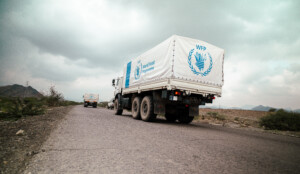OCHA Sudan bulletin 41: Nutrition treatment for 2,800 children in Sudan camps
In a screening of 61,000 displaced and refugee children in Sudan, about 2,800 children were identified with severe acute malnutrition and admitted for treatment, the UN Office for the Coordination of Humanitarian Affairs (OCHA) reports in its latest bulletin. In North Darfur’s Um Baru, 7,500 returnees received support. The voluntary relocation of 3,758 South Sudanese refugees to a new site in East Darfur was completed on 30 September. In Abyei town, 17 measles cases have been reported.
In a screening of 61,000 displaced and refugee children in Sudan, about 2,800 children were identified with severe acute malnutrition and admitted for treatment, the UN Office for the Coordination of Humanitarian Affairs (OCHA) reports in its latest bulletin. In North Darfur’s Um Baru, 7,500 returnees received support. The voluntary relocation of 3,758 South Sudanese refugees to a new site in East Darfur was completed on 30 September. In Abyei town, 17 measles cases have been reported.
In August, 21,647 children suffering from severe acute malnutrition (SAM) were treated across Sudan, according to a UN Children’s Fund (Unicef) report.
Between 29 August and 7 September, a mass Mid-Upper Arm Circumference (MUAC) screening campaign was carried out in the country in order to maximise case-finding and treatment for malnutrition during the hunger gap season. The results of the exercise are expected to be released by the Federal Ministry of Health in early-mid October.
 The 2016 Global Nutrition Report states that the wasting prevalence in Sudan is 16.3 per cent, while 38.2 per cent of children are stunted. GNR defines wasting as low weight for height, while stunting is low height for age.
The 2016 Global Nutrition Report states that the wasting prevalence in Sudan is 16.3 per cent, while 38.2 per cent of children are stunted. GNR defines wasting as low weight for height, while stunting is low height for age.
Access to treatment of acute malnutrition has increased during recent years in Sudan, reaching over 30 per cent of the number of children with acute malnutrition. However, more funding is required to address critical needs of the most vulnerable populations, especially children and women.
Support to 7,500 returnees in Um Baru, North Darfur
From 3 to 5 October, the national NGO Sustainable Action Group (SAG) distributed essential household supplies and 1,500 improved shelters to an estimated 7,500 returnees (1,500 families) in North Darfur’s Um Baru locality.
The Sudanese Humanitarian Assistance Programme Organization (ASSIST) is carrying out training and registration for its planned activities to target persons with specific needs amongst the returnees. The national NGO ANHAR is operating three clinics in the area funded by the Sudan Humanitarian Fund. Doctors Without Borders/Médecins Sans Frontières-Spain (MSF-E) is also providing health and nutrition services to returnees in the area.
More than 3,700 South Sudanese refugees relocated in East Darfur
The voluntary relocation of South Sudanese refugees from Khor Omer camp in Ed Daein, capital of East Darfur, to the new Kario site was completed as of 30 September with a total of 3, 758 individuals relocated, OCHA reports.
The UN Refugee Agency (UNHCR) will start the individual biometric registration of the relocated population soon, while preparing for the registration of refugees who will return to Kario at the end of the agricultural season.
As of 30 September, the number of registered South Sudanese refugees in Sudan stands at 251,835 people. This includes about 90,000 refugees who arrived this year.
17 measles cases confirmed in the Abyei area
As of 4 October, 51 suspected measles cases had been reported in Abyei town, Abyei Area, of which 17 have been confirmed, according to a report by Unicef in South Sudan.
In response to the high number of cases, a vaccination campaign is planned for 8 October, targeting 19,815 children aged 6 to 59 months. Unicef will be providing support for the supply, transportation, and delivery of vaccines, as well as awareness raising and social mobilisation for the vaccination campaign.
On 5 October, the International Organization for Migration deployed staff to support the vaccination campaign in the Abyei area.
According to the World Health Organization, measles is one of the leading causes of death among young children. Measles can cause serious complications, particularly in malnourished children and people with reduced immunity, including blindness, encephalitis, severe diarrhoea, ear infection and pneumonia.









 and then
and then